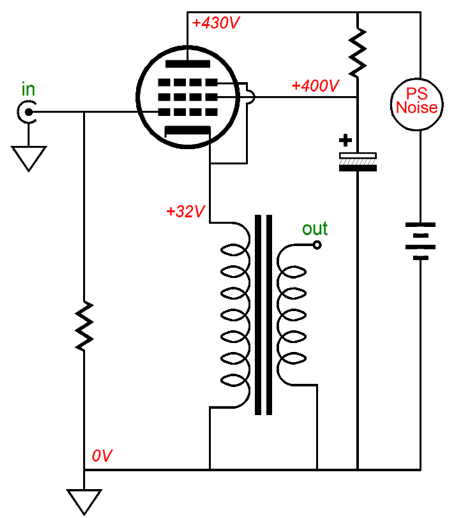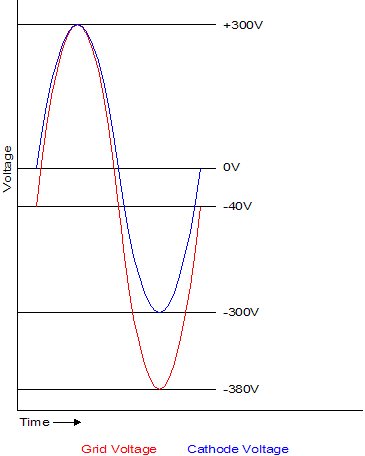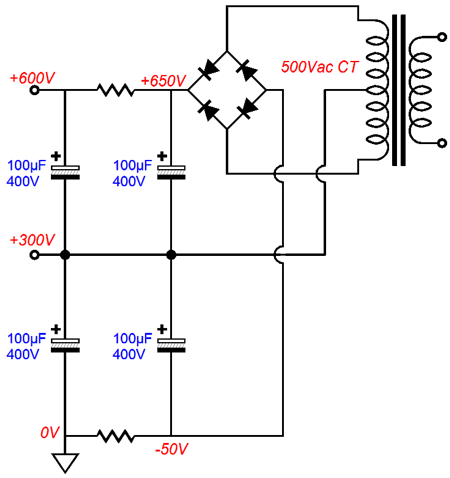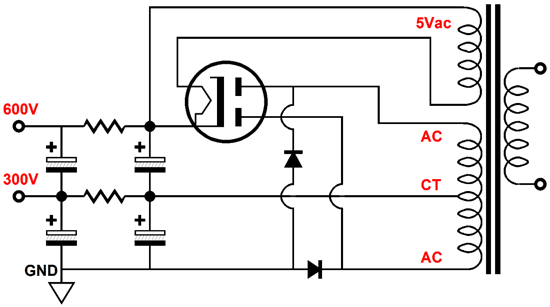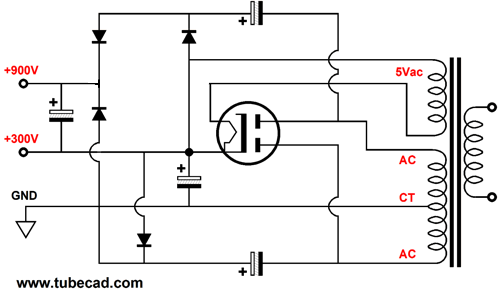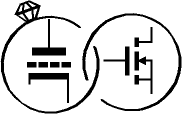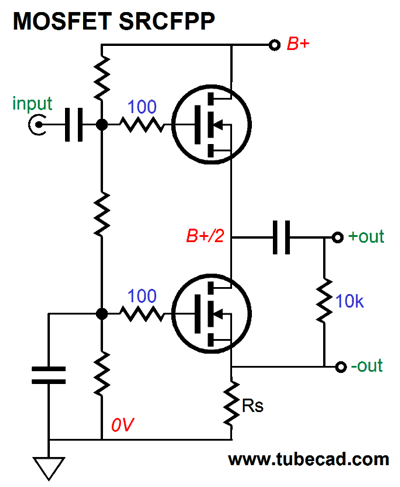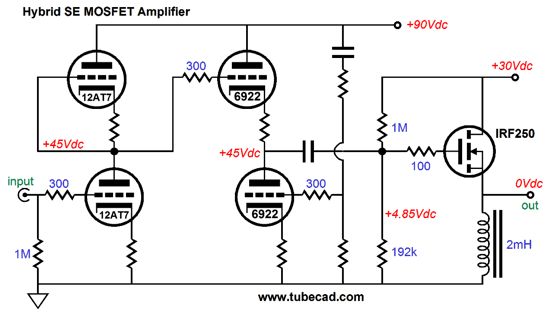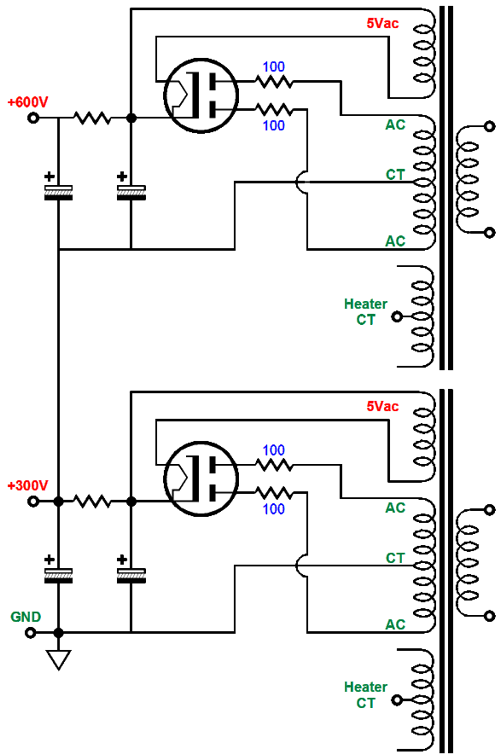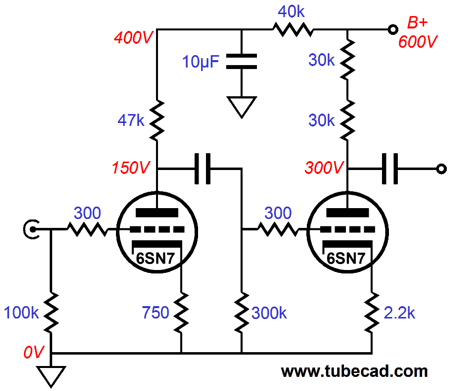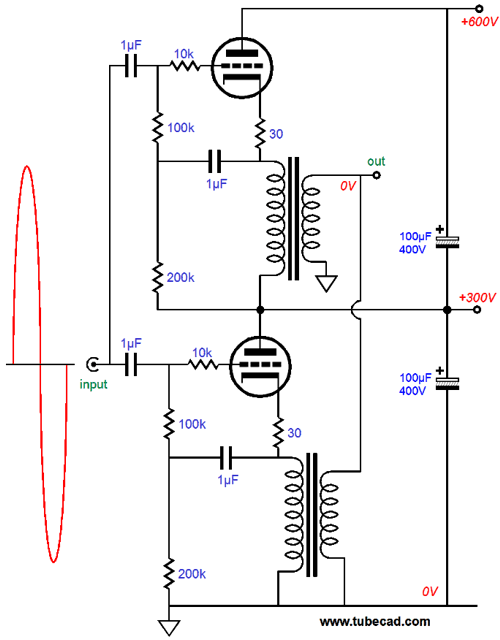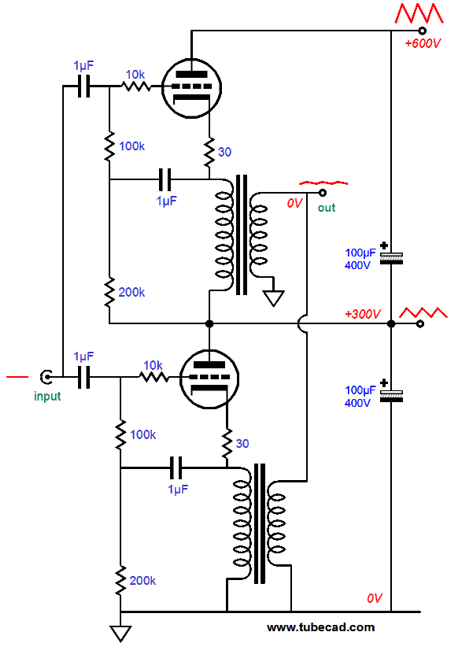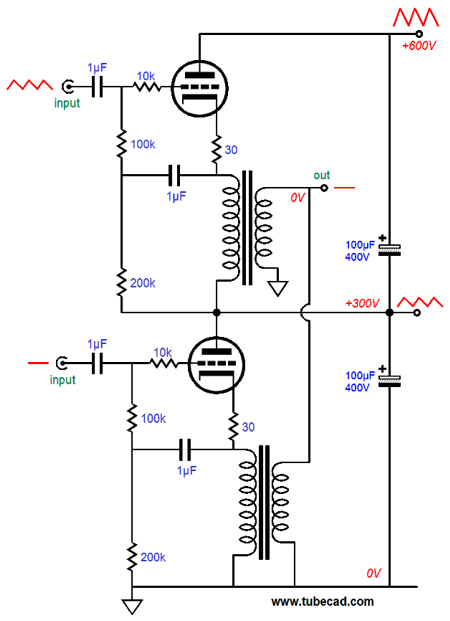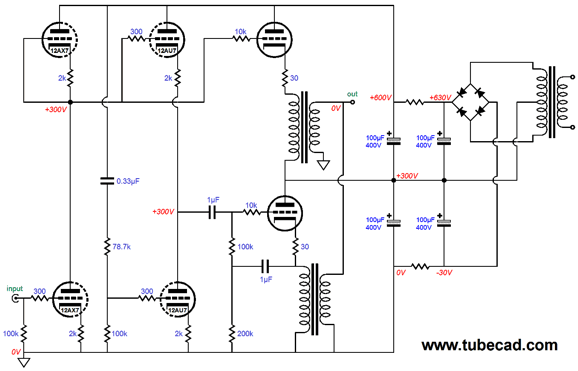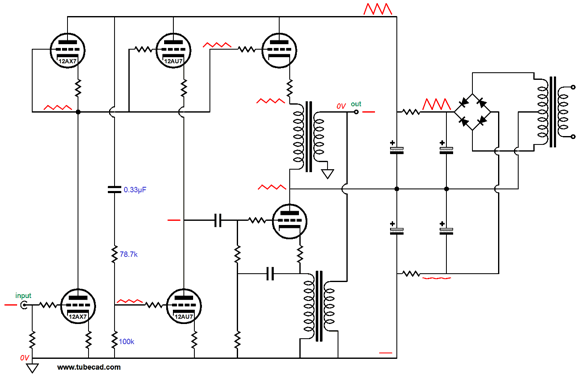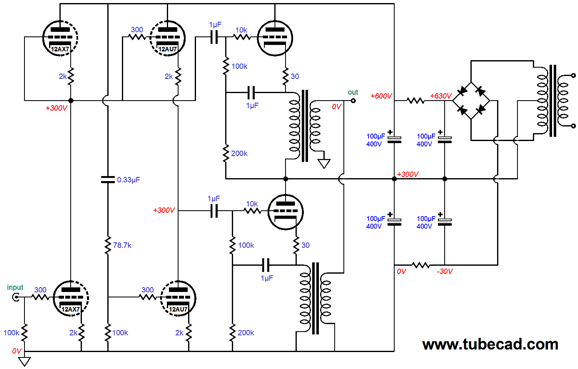| John Broskie's Guide to Tube Circuit Analysis & Design |
|
Post 230 12 May 2012
Cathode-Follower Power
This wasn't a first, as I have covered the topic many times before; see blog 149 and 148, for example. In fact, I will quote from blog 148,
Dang good question. Of course, the obvious answer is that by offering no voltage gain, the cathode-follower output stage requires too high an input drive signal. Indeed, with a transformer-loaded cathode-follower output stage, the peak-to-peak voltages will exceed the B+ voltage by almost twofold. In other words, to get a cathode-follower output stage to swing +/-300Vpk into an output transformer’s primary, with a B+ of 400Vdc, might require 680Vpk-pk of grid-voltage swing.
So it looks like the cathode-follower output stage is a non-starter. Or is it? This got me thinking: well, why not use two power supplies, one 300Vdc for the output stage and a 600Vdc power supply for the input and driver stages? In this configuration, the cathode-follower output stage could get the huge input voltage swings that it requires, without having to withstand 600V on its plate. But wouldn't sourcing a power transformer with two high-voltage secondaries be a pain? Probably so, but says that we need two high-voltage secondaries. The following high-voltage power supply uses a single center-tapped, high-voltage secondary, yet develops two B+ voltages.
This power supply is identical to a bipolar power supply, with positive and negative rails, except for where the signal reference (ground, in other words) falls. Wait minute, ground cannot just “fall” or be placed anywhere you want. Sure it can. If the ground were placed at the very top of the power supply shown above, we would have a purely negative power supply with a -300Vdc and -600Vdc rails. Okay, fine; but I use WE274B tube rectifiers, so all those solid-state rectifiers just don’t cut it. Well, you can use a tube rectifier for the output tube and two solid-state rectifiers for the input and driver stages.
In fact, we can use a voltage-tripler to create a huge B+ voltage for the input and driver stages.
Before going any further, pause and consider just how cool this power supply topology is. Now, imagine that the two rail voltages are +60Vdc and +180Vdc. The 60V rail could be used for powering a solid-state output stage; the 180V rail, the tube input and driver stage. Yes, once again, the marriage of tubes to MOSFETs.
For example, in the last post I revealed a MOSFET-based SRCFPP power buffer capable of driving loudspeakers.
This unity-gain output stage could be driven by an Aikido gain stage that ran off the +180V rail. The idea behind the single-ended power amplifier shown below is that the MOSFET is configured as a source follower and that the 2mH inductor replaces the resistor.
Don't you mean 2-Henry inductor? No, 2mH is enough, as the 8-ohm load is in parallel with the MOSFET's fantastically-low output impedance. The choke's own DCR, however, is in series with its inductance, which undermines the MOSFET's low output impedance. Thus, an air-core inductor isn't the slam dunk easy option that it might seem at first, in spite of offering such benefits as no saturation and no core hysteresis. For example, a typical 2mH air-core inductor might present a DCR of 0.3 ohms, even with 16-gauge wire, four times more than an IRFP250's 0.073 ohm Rds. In other words, a larger-valued air-core inductor will be needed, say 10mH, but then it must incur a larger DCR. In addition, the inductor's DCR will create a sizable DC offset at the output; for example, 3A against 0.8 ohms creates a 2.4Vdc offset. Thus, with an air-core inductor, an output coupling capacitor will be needed, say a 1kµF/10V capacitor. Okay, let's get back to pure-tube circuits. With two power transformers, it's easy to get two voltage rails. Moreover we need the extra heater windings, as the output tube's heater should attach to a floating heater winding referenced to its cathode, as the cathode will swing hundreds of volt up and down from ground.
Once we have established the two-rail power supply, all that remains is to design an input and driver stage, powered by the higher rail voltage, capable of swinging huge volts to drive the output tube in the cathode-follower configuration. This circuit can be as simple as the following or much, much more complex.
Such a fronted, based on 6SN7, would yield a gain of about 300, which should be plenty. Great, can we take off our thinking caps now? No. I kept thinking what a shame it is that the OPS can only avail itself to half of the potential power-supply voltage. Then it hit me: why not stack two cathode-follower OPS atop each other? Here is what I had in mind.
Remember, this is a single-ended affair, not a push-pull one, so both output tubes must see the same in-phase input signal. In addition, the 300V power-supply connection must be a low-impedance point. In other words, we can not simply stack two cathode-follower OPS with a single 600Vdc power supply. (Although, if two large-valued power-supply capacitors were used in series, as shown above, we could get away with the single 600Vdc power-supply rail, as the nexus between the two capacitors defines a low-impedance point.) Nor is this single-ended amplifier anything like the accordion amplifier I described back in 2001.
In the accordion single-ended power amplifier, both triode function in grounded-cathode-amplifier confgurations, not cathode followers. (An accordion single-ended power amplifier can be made with both output tubes functioning as cathode follower; see the PDF for details.) The totem-pole stacked cathode followers offer no voltage gain, but they do present a low output impedance. The stacking allows us to better use all the power-supply voltage. True, we will need two output transformers, but imagine how cool four output transformers would look on a stereo amplifier chassis. Here is where 99% of tube gurus would stop, pleased that had accomplished so much. I, in contrast, only see the input signal as being only one of at least two signal sources, the second being the power-supply noise. What happens when the totem-pole cathode-follower OPS sees an input signal that is noise-free and must work with ripple-burdened B+ connection? The following schematic shows the noise relationships.
The bottom triode likes the noise-free input signal, but the top triode suffers because of it, as its output transformer terminates into a noisy connection. Ideally, the top triode should see an inputs that contains the same amount of power-supply ripple as the bottom triode sees at its plate.
This is an example of why I always work backwards, when designing a power amplifier, starting at the output stage, moving to the driver stage, and ending with the input stage. Well, what sort of circuit could deliver these two input signals? How about the following design: the Aikido Totem-Pole SE CF Amplifier. The frontend is a modified Aikido gain stage, which uses two 12DW7 tubes. The top output tube gets its input signal from the Aikido's input stage, before the Aikido cathode follower can scrub away the power-supply noise, so one half of the 600Vdc ripple will appear at its output. The bottom output tube gets its input signal after the Aikido cathode follower, so its grid sees little of power-supply noise. Here are the power-supply noise relationships within the amplifier. Interesting, no? Building such an amplifier will require three heater windings: one for the top output tube and the top 12DW7, referenced to the top triode's cathode; one for the bottom output tube, referenced to the bottom triode's cathode; and one for the bottom 12DW7, referenced to ground. (I can envision just two AC heater windings being used, with each 12DW7 heater being used to bias a set of three top and three bottom output tubes, but this would be too mind-stretching for most. For those bold enough, imagine a 12DW7 heater, bypassed by a large-valued capacitor, located and in series with each output transformer primary, with the top 12DW7 heater atop the primary and the bottom 12DW7 heater below the primary. Now, with 150mA of idle current flowing through three output tubes above and below, the heater elements will see a voltage differential of 12.6Vdc. The top 12DW7's heater will be referenced to the top output tubes' cathodes, while the bottom 12DW7's heater will be ground referenced. Here is the schematic.) Note the absence of a coupling capacitor for the top triode's grid. In a perfect world, it would not be needed. In the real world, it should be included, as the input stage is unlikely to perfectly center at 300Vdc. On ther other hand, if a single 600Vdc power-supply rail is used, with two large-valued power-supply capacitors in series, then the top coupling capacitor could be ommited, as the two large capacitors will follow along in thier DC center point. By using six triode-connected EL34 output tubes and two 12DW7 Aikido tubes and two UBT-1 17W SE output transformers, we get 30W of low distortion and low output impedance, all global-negative-feedback free—and a lot of heat. Just imagine the phalanx of tubes, the heft of iron, the warm glow of tube glory, the smile on your ears...the pain in your wallet.
Next Time
//JRB |
|
I know that some readers wish to avoid Patreon, so here is a PayPal button instead. Thanks.
John Broskie
E-mail from GlassWare customers:
And
High-quality, double-sided, extra thick, 2-oz traces, plated-through holes, dual sets of resistor pads and pads for two coupling capacitors. Stereo and mono, octal and 9-pin printed circuit boards available. Aikido PCBs for as little as $20.40 http://glass-ware.stores.yahoo.net/ Only $12.95 TCJ My-Stock DB
Version 2 Improvements *User definable Download or CD ROM www.glass-ware.com |
||
| www.tubecad.com Copyright © 1999-2012 GlassWare All Rights Reserved |

